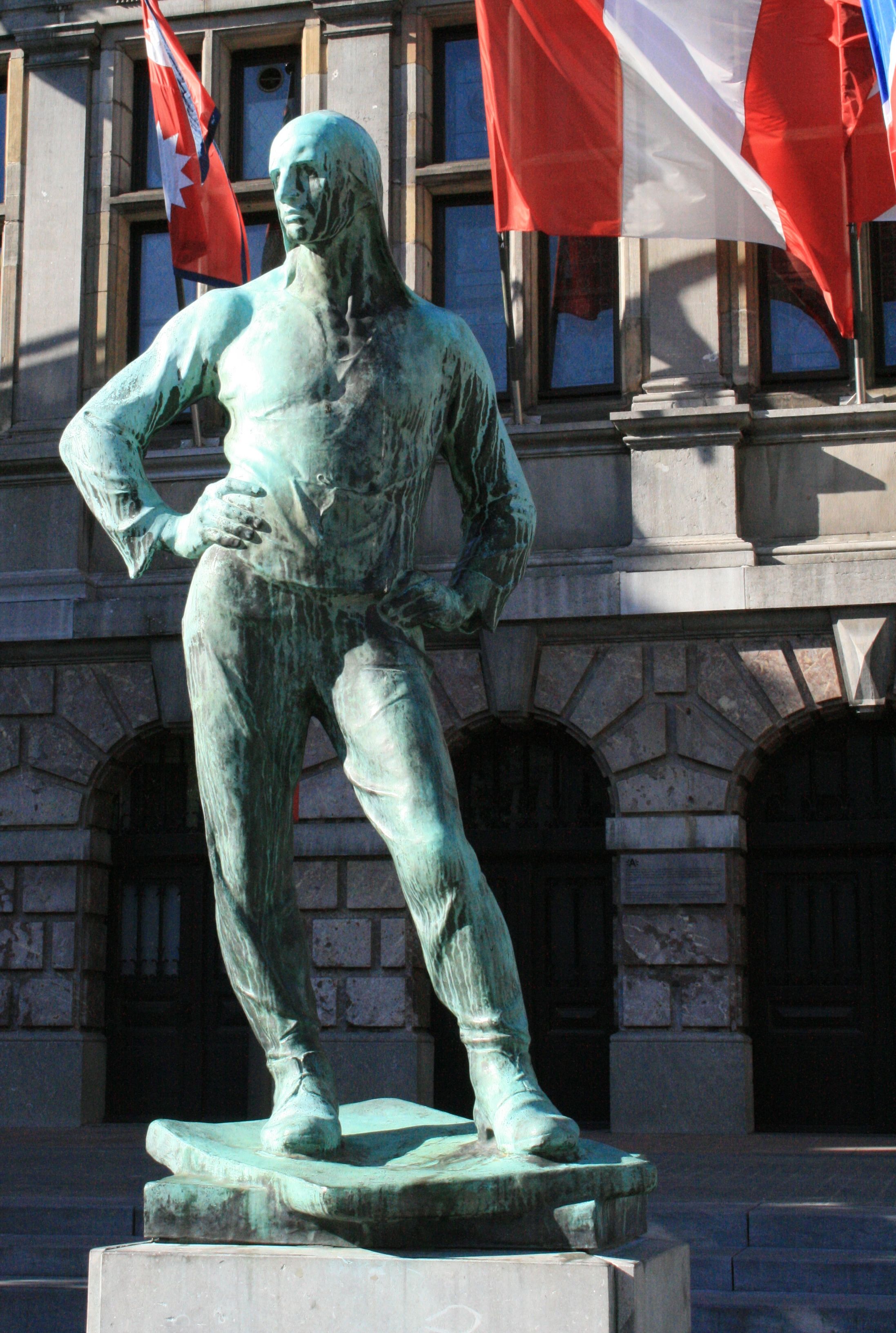
Balthasar Paul Ommeganck, founder of the association “De Konstenmaetschappye” (the Arts Society)
18th CENTURY
In 1786, on the eve of the French Revolution, Balthasar Paul Ommeganck, Hendrik Frans de Cort and some other ‘fellows in the arts’, gathered in Antwerp and formed a fellowship of artists. A few years later, in 1788, this fellowship wrote down the articles for an association, “De Konstenmaetschappye” (The Arts Society), which was founded shortly thereafter. These megalomaniac artists, dreaming of restoring the once important age of P. P. Rubens, did not assume for a moment that their association would make history. The eighteenth century art scene could not have known that for society art would become more important in the next century than ever before. Art would shift to the centre of social life.

Baron Gustaaf Wappers, the most important Belgian painter of the Romantic era, was the association’s artistic Chairman from 1844 to 1853
19th CENTURY
After the admission of members belonging to the local bourgeoisie the association, initially founded for purely artistic reasons by artists, changed and became of social importance in the beginning of the 19th century. Accordingly the association renamed itself “Maetschappij ter Ondersteuning van de Schoone Kunsten” (Society in Behalf of the Fine Arts). This new impetus came from B.P. Ommeganck and Willem Jacob Herreyns, of which the latter founded the Academy of Arts in Malines in 1772.
The official articles of 1816, in which the bourgeoisie and artists made a social pact, defined the association’s actions throughout the entire 19th century. In 1817 the association was allowed to add the title ‘Royal’ to its name because of its firmness in retrieving the art treasures stolen from Flanders by Napoleon. These were taken out of the Louvre with the help of Prussian soldiers. The retrieved works of art were brought together in a newly founded museum. Florent Van Ertborn, an aristocrat and Chairman of the association between 1820 and 1826, donated his collection of ‘Flemish Primitives’ to this new museum in his will. The association grew swiftly, partly due to the rise of nationalism and the search for the roots of the young Belgian nation. This was expressed in the aspiration to emulate the historical past in works of art. In this period triennial ‘Salons’ were established, which alternately took place in three cities. From 1830 to the end of the century, these exhibitions remained the only official Belgian exhibitions.
In 1840 the salons began to work together with artistic correspondents who recruited artists from all over Europe (Düsseldorf, Vienna, Rotterdam, Bremen, Hamburg, Munich, Prague, …). In 1860 St. Petersburg and New York were added to the list.
The distribution of power in the association drifted between artists and patrons. Arts in the 19th century were becoming increasingly important and were obviously committed to experiencing more quality in each work. At the same time artists began to deploy themselves more and more freely towards society. Starting from a kind of opposition towards society, progressive artists began to add a pictorial side to the political struggle. ‘Individualism’ was born.
In the 19th century it came to sporadic clashes in the association between the artists and the patrons, who were mostly conservative and not inclined to innovation. Whereas the activities at the beginning of the century were encouraged and impelled by the romantic school, the power stayed in the same hands. This in spite of the artistic and social innovations of the time. By-passed by history, those in charge of the association were considered as artistic conservatives.
Moreover there was a controversy in the press that lasted into the last decade of the century until ultimately society in general and the association itself opened up to movements which stood for innovation towards the arts. This fact was also noticeable in the “Prix de Rome”, which was organized by the association, with involvement from high society personalities. This acceptance of the association of innovation in the arts took place under the chairmanship of Arthur Van den Nest, an alderman of Antwerp and MP. In the 19th century the association co-founded the “Antwerp Museum of Fine Arts”, increased the collection of this new museum and assisted in 1890 in the relocation of the museum to the neighbourhood “South”, its present location in Antwerp.

The Dock Worker”, by Constantin Meunier, 1885, was bought and donated to the Royal Museum of Fine Arts Antwerp
20th CENTURY
During the 20th century, which was divided by two world wars in three periods, the association placed itself in the field of art mediation. Artworks were purchased to complement the museum collections (“Crazy Violence” by Rik Wouters, “Citizens of Calais” by Rodin, “The Dock Worker” by Constantin Meunier, …).
The artists, core members of the association, advised leading members of the Antwerp bourgeoisie in the creation and expansion of their collections. In this way many up-coming artists were abundantly helped in the development of their careers.
During the interwar period the articles of the association were adapted to be in accordance with modern legislation. In 1936 it was decided to alter the existing association into a non-profit association with shareholders. All the local notables of that time sat on the Board of Directors. Then it was probably the most prestigious assembly of its time. Cléomir Jussiant, an important art collector and patron, was president from 1938 to 1957 and he managed to give the association a dominant character in the perception of art in the city of Antwerp.
After World War II the Belgian economy was so shaken up that the association could no longer maintain the monopoly it had previously held. Meritocracy brought a new class to power that wanted to explore new cultural horizons and as a result several new patronage associations made an entrance. At that time the RSEFA was no longer active nationwide. The last ‘salon’ was held in 1951 and from then on only retrospectives were organized. The art world was becoming more global, more international, but the existing non–profit association as such did not respond to this change. The individual freedom of the individual artist increased and this freedom became proportionally threatening to the social status of the bourgeoisie. In response to this the shareholders kept their grip on the activity of the association, which made its influence wane further. The association subsidized the travels of up-coming artists and limitedly kept on buying works made by young artists. In 1976, the association organized a retrospective and became involved in a new non-profit association to support the Academy (Royal Academy of Fine Arts Antwerp), called “VrikA” or “Vriendenkring” (the Academy’s Circle of Friends). In this way the association financially supported the social action of this new undertaking.
In 1995 (after the death of L. Gyselinck) a notary wanted to abrogate the association, but the file ended up on the desk of the newly appointed director of the Royal Academy of Fine arts Antwerp, Bart’d Eyckermans, who refused to sign the dissolution of the association. He obtained the admission of a new member into the association, Dr. Guido Persoons, and convinced a lawyer, Dr. Jan Verwijver, who was the secretary of the association between 1961 and 1972, to back up the association again. The association was then adapted to the latest legislation concerning non-profit associations and the existing official articles were rewritten. An action plan for the association to give it a new start towards the 21st century was implemented.

Purchase of “Crazy Violence” (1912) by Rik Wouters . This work of art was donated to the Royal Museum of Fine Arts Antwerp
21st CENTURY
The association established itself at the “Royal Museum of Fine Arts Antwerp”. Various exhibitions/competitions with different themes aimed at a diverse artist audience took place there. The themes varied from “XL” to “Portrait”. The organization focused on the largest possible number of regional academies. Because of the closure of the museum, due to renovations, the need for other locations to organize events arose. During the 21st century the tradition of furnishing Salons from the 19th and 20th century was re-installed. The difference with the previous centuries is that the non-profit organization now focuses solely on young graduate artists. In contrast to the Salons of the 20th century, which retreated to the national, we are now in tune with international oriented tradition of the 19th century. These days, annual salons promote young up-coming European artists. During the first edition of the Masters Salon only Belgian Academies participated. The following year it turned into a Benelux edition to spread from that year on to a European competition all together.

The award ceremony of the contest “Portrait 2010” at the “Royal Museum of Fine Arts Antwerp”. Speech by Dr. Guido Persoons, the Chairman of the RSEFA
The Covid pandemic disrupted the annual Salons what caused a change in the format. Instead of organising an overview of the cum laudum graduating students of teh European academies the npo returned to a theme contest open to all former participating academies. This resulted in the event “Marriage Stories” in 2023.

Masters Printmaking 2018

